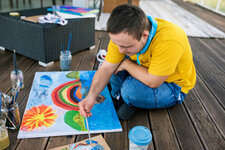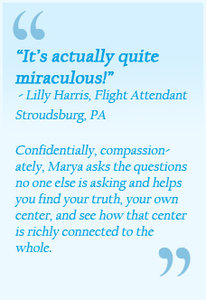Ten Days of Giving - Day #2 - The Gift of Memory

Aloha Kakou!
Gifts are like drops of nectar in a forest of color. Both giver and receiver replenish and renew. Some people can only see black and white, and when you give a simple gift, it can colorize the world again.
Take for instance the gift of memory. It can help us see how positive streams of kindness, compassion, and generosity may be nourished and grow over time, and how thrilling it is when you see or read about memory in the present, seeing it as a perfect seed to so much that came after.
The past is like an alpine stream foreshadowing of a certain type of energy gushing into the wider river below.
I was eleven years old when the Murray Children’s Center opened near my home. I had a friend down the street whose brother was developmentally disabled. He loved everyone he met, saying, “I love you” to me, my dad, and the postman. No one was unworthy of the benevolent eye of his big heart or his huge hugs. He ran and he played with us, acting our age and being more fun because he was older. We were lucky to know him.
And he was lucky. The kids at Murray Center were not so fortunate. I had not seen that level of severe disability, but when a class project forced me to read a newspaper, I was stunned by the photos I saw and what I read about a disabled person’s care. “We need all the help we can get,” said the center director in the article. “Our clients have a broad spectrum of psychiatric, psychological, and medical needs. They have physical, social, educational, and vocational limitations that require daily rehab and recreational, speech, language, hearing, and occupational and physical therapy. We provide for all of them.”
It astonished me that someone could need so much, and I was angry that the God they taught me about in Catholic School wasn’t caring for these people. Who was responsible for hurting them? Why? Why hurt someone so much that they suffered like that? Why should they be so vulnerable and needy when I had so much? What could I do to help?
The Murray director added, “They even need to play. And we don’t have a budget for toys yet.”
“Toys,” I thought. I could raise money to buy them toys. Notice the consumerist thinking here? Not what could I make them, but what could I buy? I did have enough sense to think I could create something to make the money to fund their toys, so they could play, have more fun, and have more color in their lives. I had a hunch: Maybe they could get better if they felt better.
But some couldn’t walk or talk or eat by themselves. What kinds of toys? We would give money to the center and they would know. My allowance was $1 a week. That would barely buy a Slinky and couldn’t touch a Chatty Cathy.
Some friends and I had thought about getting together a variety show on the sidewalk in front of my girlfriend’s house. We hatched the plan of making a Show as a fundraiser for the Murray Children’s toys. We would charge 25 cents and make lemonade to sell. We got busy on Tuesday, rounded up Maple Street’s hottest acts, and in four days, conceived, rehearsed, and built the set with blankets, a bicycle, and odd furniture. With a hefty dose of stardust dreams.
We sang “This Land is Your Land,” together and everyone’s heart swelled. In retrospect, I see how colonialist the message might seem from a Native American point of view, but when Woody Guthrie wrote this as a protest song in 1940, his message was one of human rights, inclusion, and equality. The part that made us happy was the line, “This land was made for you and me,” which was the American ideal in simple, eloquent language. At the neighborhood Show, we managed — by accident – to sing that part in harmony. At 11, my heart was bursting with something beyond joy. Ecstasy.
What Guthrie wanted was a society where the real commonwealth – the land, the water, the sky – was valued. We would share responsibility for and benefit from these healthy resources Nature is lending to us. Indigenous, Black, White, Yellow, and Red would co-exist harmoniously, Guthrie thought, if it weren’t for exploitative capitalism. But that’s another story.
At the big fundraiser event, we raised $3.67. I put it in an envelope and mailed it to the director at Murray Center, taping the 67 cents to cardboard to be sure it didn’t jangle around. I felt better than I had ever felt in my life. I was helping someone to live a better life. I was giving a gift that in many ways I wanted for myself too. I wanted to keep the inner color, my imagination, and the ability to create, the very qualities that my society and environment were unconsciously thwarting in everyone, child and adult alike. And the loss of soul, the loss of creativity, is literally killing us.
Especially if you’ve been conditioned to see the world as black and white, one little gift can enliven the heart and open the inner eye to fertile greens, sunny yellows, and an array of blues and violet – all the emotions and feelings and frequencies in life’s full palette. And by filling another’s need for color, your own spiritual palette grows too.
So you see, my need for improvising skits and songs for theatrical and visual arts variety show fundraisers to serve children’s needs started early. It just happens to be a thing of mine, I’ve learned, a gift I have chosen to give many times over, because it truly is better to give than receive.
Giving the gifts of color, emotional regulation, a playful attitude, song, and movement helps to weave anew and restore core nerve connections in a child’s body and brain, especially in children dampened and flattened by disability, trauma, war, domestic violence, excessive stress, and grief.
The full rainbow of colors, energies, emotions, and thoughts may be narrowed by genetics, anatomy, or circumstances; the narrowing may be environmental, such as witnessing a school shooting or reading about war crime victims. A person’s view, whether child or adult, naturally narrows to prevent the full negative impact of whatever trauma is experienced. It protects the person’s soul from wounding.
Sometimes the soul exits the body as another protective defense against trauma, which has advantages, but it can also damage people long-term. It can disconnect insight, stall creativity, and evaporate the color harmonies so essential to full-frequency living. Existence shrinks into a world of black and white.
Painting Peace Flags changes all that. Learning to embody peace, imagine peace, and paint a full array of dreams on silk given hundreds of painters their color back.
Teaching Peace Flag-making to all levels of students, from beginner to gifted, I have learned this: It is a key that opens a child’s and adult’s heart and soothes their soul. Trust and confidence return. It’s like giving someone their spirit back. But really, they are taking it back from inside themselves, from a pure, powerful place that they can rely on.
If you are called to support ArtWavEs, please DONATE TO AWE HERE
If you want to learn more about the ArtWavEs mission, please view this brief video. And please spread the good word by sending it to friends! ARTWAVES VIDEO
We wish you and your ‘ohana a safe, healthy, and warm holiday. See you next time with the third installment in our Ten Days of Giving Campaign.
Me ke aloha,
Marya
For Pacific ArtWavEs
On behalf of the Creative Council


